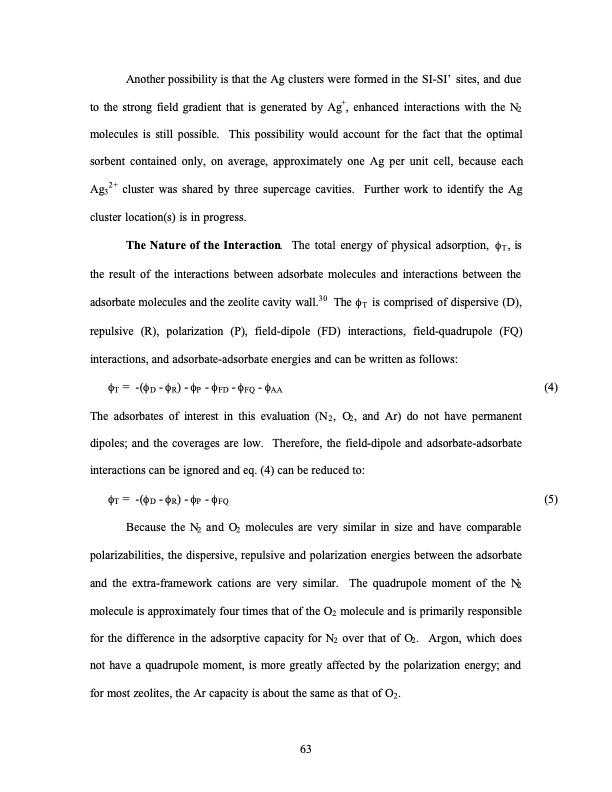
PDF Publication Title:
Text from PDF Page: 063
Another possibility is that the Ag clusters were formed in the SI-SI’ sites, and due to the strong field gradient that is generated by Ag+, enhanced interactions with the N2 molecules is still possible. This possibility would account for the fact that the optimal sorbent contained only, on average, approximately one Ag per unit cell, because each Ag32+ cluster was shared by three supercage cavities. Further work to identify the Ag cluster location(s) is in progress. The Nature of the Interaction. The total energy of physical adsorption, φT, is the result of the interactions between adsorbate molecules and interactions between the adsorbate molecules and the zeolite cavity wall.30 The φT is comprised of dispersive (D), repulsive (R), polarization (P), field-dipole (FD) interactions, field-quadrupole (FQ) interactions, and adsorbate-adsorbate energies and can be written as follows: φT = -(φD - φR) - φP - φFD - φFQ - φAA (4) The adsorbates of interest in this evaluation (N2, O2, and Ar) do not have permanent dipoles; and the coverages are low. Therefore, the field-dipole and adsorbate-adsorbate interactions can be ignored and eq. (4) can be reduced to: φT = -(φD - φR) - φP - φFQ (5) Because the N2 and O2 molecules are very similar in size and have comparable polarizabilities, the dispersive, repulsive and polarization energies between the adsorbate and the extra-framework cations are very similar. The quadrupole moment of the N2 molecule is approximately four times that of the O2 molecule and is primarily responsible for the difference in the adsorptive capacity for N2 over that of O2. Argon, which does not have a quadrupole moment, is more greatly affected by the polarization energy; and for most zeolites, the Ar capacity is about the same as that of O2. 63PDF Image | PSA USING SUPERIOR ADSORBENTS

PDF Search Title:
PSA USING SUPERIOR ADSORBENTSOriginal File Name Searched:
789503.pdfDIY PDF Search: Google It | Yahoo | Bing
CO2 Organic Rankine Cycle Experimenter Platform The supercritical CO2 phase change system is both a heat pump and organic rankine cycle which can be used for those purposes and as a supercritical extractor for advanced subcritical and supercritical extraction technology. Uses include producing nanoparticles, precious metal CO2 extraction, lithium battery recycling, and other applications... More Info
Heat Pumps CO2 ORC Heat Pump System Platform More Info
| CONTACT TEL: 608-238-6001 Email: greg@infinityturbine.com | RSS | AMP |